Edward Powell
Oud Junkie
    
Posts: 1212
Registered: 1-20-2008
Member Is Offline
Mood: g'oud
|
|
BUILDING WOOD SAROD (for Arnab Chakrabarty)
Hi, I'm back in Europe and starting work on two instruments I need to build for a couple of good friends.
One instrument is an exact copy of Ragmakamtar #9 - and while I'm waiting for the wood to start that one, I began work a WOOD SAROD for Arnab
Chakrabarty. Arnab and I have been discussing this for a few years now and I've been trying to encourage him to build one himself - but finally he
just asked me to do it for him.
Basically it is a hybrid SAROD and OUD... totally sarod strings, but the body and soundboard very similar to oud. Interest in that the "FLAT TOP"
thin soundboard type instrument has never been used in Indian instruments. . . so this is a first (as far as I know).
I am confident it is going to sound great - but to be sure we will have to wait and find out. . .
. . .stay tuned!
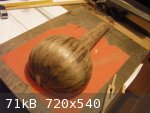
|
|
|
Edward Powell
Oud Junkie
    
Posts: 1212
Registered: 1-20-2008
Member Is Offline
Mood: g'oud
|
|
&
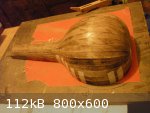
|
|
|
Edward Powell
Oud Junkie
    
Posts: 1212
Registered: 1-20-2008
Member Is Offline
Mood: g'oud
|
|
&
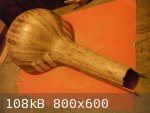
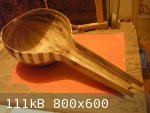
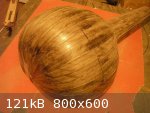
|
|
|
urus
Oud Junkie
    
Posts: 120
Registered: 3-20-2010
Location: Cairo, Egypt
Member Is Offline
|
|
!!!

|
|
|
Arto
Oud Junkie
    
Posts: 120
Registered: 4-1-2006
Location: Finland
Member Is Offline
Mood: No Mood
|
|
"Interest in that the "FLAT TOP" thin soundboard type instrument has never been used in Indian instruments. . . so this is a first (as far as I
know)."
Interesting. I have never thought about what kind of wooden tops sitar, Saraswati veena, sursingar etc etc have. Thick tops? carved?? no braces? I
have Dr Kasliwal´s book Classical Musical Instruments and it seems to give no information how the tops are made.  Arto Arto
|
|
|
Edward Powell
Oud Junkie
    
Posts: 1212
Registered: 1-20-2008
Member Is Offline
Mood: g'oud
|
|
Basically all Indian stringed instruments to my knowledge are either skin of carved hardwood (5mm), no braces.
|
|
|
Jody Stecher
Oud Junkie
    
Posts: 1373
Registered: 11-5-2011
Location: California
Member Is Offline
|
|
I have yet to see a thin soundboard on an Indian classical instrument. But I *have* seen a fair number of Indian classical instruments with flat
soundboards. A friend in Seattle has a Varanasi-made, all-wood surbahar with a completely flat soundboard and a round sound hole. Although my Hemen
sursringar has a sloped top (soundboard) the top of my Mohan Lal Sharma sursringar is almost flat; you wouldn't be far from wrong calling it flat
although there's a very slight slope just on the borders. But the top is thick. I have seen Saraswati veena-s with flat tops. Vicitra Veena sometimes
has totally flat top, some slope down at the edges. All these have thick tops. Probably the intent is to increase sustain by keeping the energy in the
string. There is evidence that some sort of tanbur was played at the court of Akbar. Whether they played raga music or maqam music is not clear. The
contemporary accounts make it clear that this "tanbur " was a long-necked flat-topped melody instrument, not a drone instrument like tamboura or
tanpura.
|
|
|
Edward Powell
Oud Junkie
    
Posts: 1212
Registered: 1-20-2008
Member Is Offline
Mood: g'oud
|
|
Interesting... so you have seen some flat thick soundboards... So to my knowledge the "thin/braced" soundboard has never been used in India
(traditionally). I actually wonder why that is?
Anyhow, here are a couple more fotos of progress on the WOOD SAROD (thin braced top).
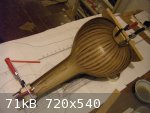
|
|
|
Jody Stecher
Oud Junkie
    
Posts: 1373
Registered: 11-5-2011
Location: California
Member Is Offline
|
|
Quote: Originally posted by Edward Powell  | Interesting... so you have seen some flat thick soundboards... So to my knowledge the "thin/braced" soundboard has never been used in India
(traditionally). I actually wonder why that is?
|
I think that there may be three reasons for the thickness. One is to support the relatively massive and heavy jawari bridge. Also the thick top
doesn't vibrate very well and the transfer of energy from the strings to the top is inefficient. That might be reason number 2. The energy stays
longer in the string and the sustain (which is desirable in these instruments) is increased. The third reason is that "this is how my grandfather did
it".
|
|
|
Edward Powell
Oud Junkie
    
Posts: 1212
Registered: 1-20-2008
Member Is Offline
Mood: g'oud
|
|
well it takes more technology to get a soundboard really thin... however in Europe they have been using thin soundboards for hundreds of years.
|
|
|
Edward Powell
Oud Junkie
    
Posts: 1212
Registered: 1-20-2008
Member Is Offline
Mood: g'oud
|
|
...almost finished
|
|
|
Edward Powell
Oud Junkie
    
Posts: 1212
Registered: 1-20-2008
Member Is Offline
Mood: g'oud
|
|
finally finished and delivered this baby... here is me testing it out
http://www.youtube.com/watch?v=6pYZJoOFMas
...and here is Arnab playing it (however keep in mind that on this day he decided against my better judgement to slightly shorten the scale because he
was used to a slightly different scale at that time.... so the tone is about 80% of what it really is)
http://www.youtube.com/watch?v=dtoZ5T-P99M
|
|
|
Jody Stecher
Oud Junkie
    
Posts: 1373
Registered: 11-5-2011
Location: California
Member Is Offline
|
|
Wow, the clip of you playing really sounds good. I agree that the sound is not as good in the Arnab clip. What is the difference in the plectrums
used?
|
|
|
Edward Powell
Oud Junkie
    
Posts: 1212
Registered: 1-20-2008
Member Is Offline
Mood: g'oud
|
|
I used a sitar mizrab, and arnab used a coconut pic I think...
It's a pity I should have recorded this more what I still had it..... hmmmmm.... actually now that I think of it I did make some very long mp3
recordings of it. Have them somewhere. It is a really beautiful sounding instrument. Arnab wanted the soundboard paper thin so I went absolutely as
far as I could go with thinness and the thing is on the verge of collapse - arnab is very brave. The result is an ultra sweet sound, but probably
lacks power and projection that you will get with a more sturdy soundboard.
|
|
|